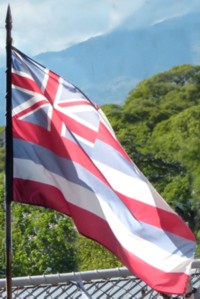Sugar and Immigration
The year Queen Kaahumanu died, an American, William Northey Hooper, had sailed from Boston and leased 980 acres of land from Kamehameha III. Hooper would be the first of a group of American plantation entrepreneurs to attempt to grow sugarcane for the export market.
Sugarcane had long grown here. The cane was among the plants introduced by the Polynesians. By 1829 the Rev Joseph Goodrich was already milling 'a year's supply' of sugar and molasses' at Hilo. But until now it had been for local consumption.
Initially the prospects for export were poor. It was tens of thousands of miles to New York or London by sea. How was Hawaii to compete with plantations in the Caribbean and in the southern states of the US that were very much closer to these markets and where slave labour could be employed?
Luckily for the struggling sugar growers, two decades later gold was discovered in California and in 1849 300,000 'forty-niners' invaded that sparsely populated, previously Spanish, territory displacing the locals and laying waste to the land. All these people had to be transported and fed. The US economy boomed as a result and within two years the booming Republic of California had joined the US Federation. Suddenly shipping was in Hawaii's favour. It was far cheaper to ship sugar in bulk by sea to San Francisco than overland from the southern states by wagon. Fate had delivered the Hawaiian sugar planters an answer to their prayers.
A huge expansion was required. With a devastated native population there was plenty of suitable land well-watered land, blessed with rich volcanic soil and a relatively compliant, pro-development, government. But there was no suitable labour force.
Before today's mechanical harvesters sugarcane planting and cutting was particularly arduous. Not only had the Hawaiian workforce been devastated by disease, those other European gifts: alcohol; opium and tobacco played their part too. Planters complained that many native Hawaiians saw no sense in arduous work on the plantations when they could easily subsist on land that they now owned under land reform. Even at its peak the native workforce willing to plant and cut sugarcane never grew to more than two thousand.
In American, until 1865, sugar growers had resolved this by buying slaves or enslaving native people. But this was not possible in Hawaii. The British were already committed to the abolition of slavery throughout the Empire and 1852 King Kamehameha III gave his assent to a new constitution introducing a Declaration of Human Rights, adopting these principles and giving more power to the people. Hawaii plantation owners would have to look elsewhere.
Their solution was to employ indentured labour. This is where a worker is bound by contract to work for a particular employer for a fixed time and rate of pay. These workers were recruited from around the Pacific, beginning with the first group of Chinese in 1850.
Now sugar would surpass whaling as the mainstay of the Hawaiian commercial economy. In any case whaling would soon be made less essential by the success of Rockefeller's Standard Oil, substituting mineral oil for lighting, heating and lubrication, surpassed in due course, in the 20th century, by: automotive; aircraft; shipping; and industrial applications.
In all some 50,000 Chinese spent time working the cane fields. But more than half of them quit to become subsistence farmers. This led to difficulties in enforcing the conditions of the indenture as the Chinese would simply walk off the job, like any free worker, if conditions were too onerous or the pay too low. The Planters' Society began to cast about for a more compliant workforce.
In 1878 the first Japanese peasants arrived to work on the plantations. The Japanese would eventually outnumber all other ethnicities. That year too, the economically struggling Portuguese territories of the Madeira Islands, and the Azores, where sugar was already grown, would provide another 3,300 cane workers, bringing different traditions. Manuel Nunes, a Portuguese who arrived in Hawaii in 1879, is credited with introducing the Ukulele, once a small Portuguese guitar, to Hawaiian culture.
According to Wikipedia: In all some 200,000 Japanese workers arrived with 55% returning to Japan. Between 1903–1910, 7,300 Koreans arrived and only 16% returned to Korea. In 1906 Filipino people first arrived. Between 1909 and 1930, 112,800 Filipinos came to Hawaii with 36% returning to the Philippines.
Sugar Plantation 'Laborer' Statistics Report - December 1897 - Plantation Museum
Note that even the Portuguese outnumber Hawaiians and half the total workforce is Japanese
This time wives were encouraged to accompany the workers because families are more dependent on a regular pay packet and a cast system was evolved under which the different ethnic groups were kept apart and granted different hierarchical status. These measures were deliberately designed to mitigate against coordinated industrial action to sue for better conditions. Nevertheless the workers did indeed strike and suffered draconian punishments.
Industrial action by Sugar Workers - Plantation Museum
In 1900 Indentured Labour was identified as a form of slavery and abolished
During the 20th century sugar growing in Hawaii became progressively less economic -
in part because of repeated damage to wharves, storage and rail facilities by a series of Tsunami
Meanwhile sugar growing in Australia became more economic when the high cost of labour
as a result of the 'basic wage' led to improved farming practices and increased mechanisation

